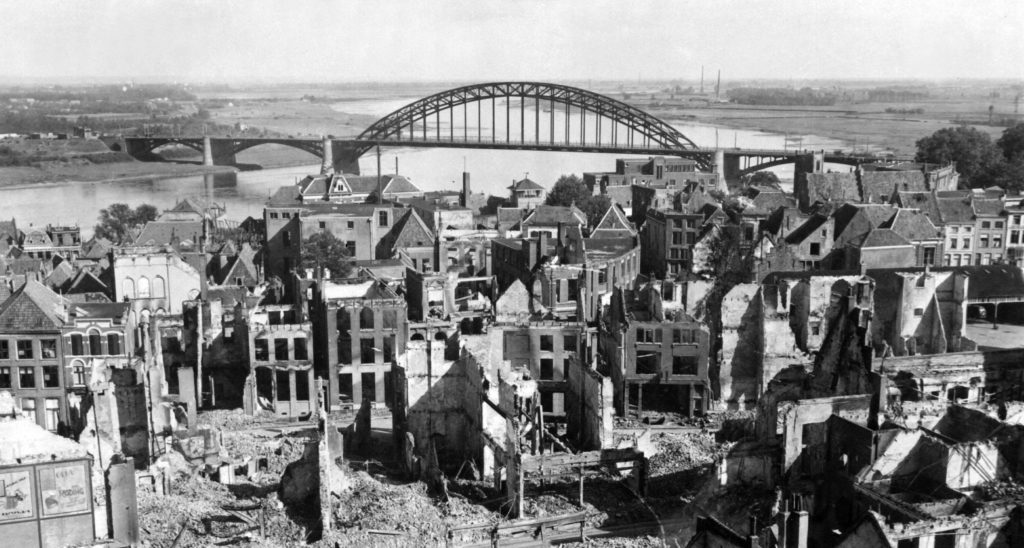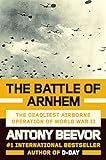The Battle of Arnhem is a brilliant book by Antony Beevor, an author who, it can be argued, has taken the place of the late Sir John Keegan, his former teacher, as the foremost military historian writing in the English language today. It is a gripping story, researched with extraordinary thoroughness: a huge number of sources are cited and woven together in a way that never strains the narrative. The book casts a spell as Beevor details how this insane military operation was conceived, planned (with notable misgivings), and executed bravely but with very inadequate support. Over the course of nine days, Operation Market Garden, as it was called, descended into shambles. It was the last significant defeat of Western arms in any theater in World War II; despite being the subject of a famous film and many books, it has been underpublicized as the disaster it was.
By World War II standards, Arnhem was not a particularly large engagement. Total British, American, and Canadian casualties were about seventeen thousand men out of around sixty thousand engaged, forty-two thousand of them airborne troops. (By comparison, the Americans took over sixty thousand casualties at Okinawa, and the Allies had ninety thousand casualties in the Battle of the Bulge—seventy-seven thousand of them Americans.) But it severely battered the airborne capabilities of the Western Allies, inflicted a delay that facilitated the German offensive of the Battle of the Bulge two months later in December 1944, and, due to a lack of supplies, stalled the much more promising and successful drive in the center of the front, led by General George S. Patton’s Third Army.
The Battle of Arnhem began as a response to fuel shortages, which, as Beevor argues convincingly, occurred because the British ground forces commander, Field Marshal Bernard L. Montgomery, refused to take the Port of Antwerp, choosing instead to try to move through the difficult terrain of central Holland with many rivers and canals on a narrow stem from the supply source in Normandy.
Montgomery had about twenty-two divisions in his Northern Army Group (including the Canadian and Polish divisions). By comparison, General Eisenhower had roughly seventy-five American divisions and ten French in the Central and Southern Army Groups in his Allied Expeditionary Force. Montgomery must be credited with considerable political ingenuity in persuading Winston Churchill to insist that Eisenhower allow Montgomery to attempt this breakthrough into Germany at the northern end of the front. It is generally believed, including by Beevor, that although Montgomery, usually an astute and cautious commander, had persuaded himself that Operation Market Garden was a brilliant enfilade and a penetrating maneuver, he was largely motivated by an ambition to take the lead role on the Western Front and head the charge into Germany. Certainly, this would be his only chance to spearhead the Western Allies, as American forces and supplies were pouring into the theater, and American officers were not enthused by the prospect of being commanded by Montgomery (especially after Market Garden).
The plan was to use airborne troops to “unroll a carpet” for the heavy units and infantry across the Netherlands and then to strike southeast into Germany. Almost everyone except the blind Montgomery loyalists had serious concerns about it. Montgomery had been urged to take Antwerp and the Scheldt Estuary by Eisenhower and others, especially Admiral Bertram Ramsay, the Allied naval commander who had conducted the evacuation from Dunkirk in 1940 and the naval aspects of the Normandy landings four years later. Having ignored their counsel, Montgomery had no idea what German forces were on his left in this attack and mistakenly assumed that they were negligible. Eisenhower was a soldier-diplomat who went to great lengths to conciliate his British Allies, who—although the United States provided most of the ground forces—were the base for the invasion of Northern Europe and initially provided about half the air forces and the great majority of naval and maritime support.
Beevor is able to preserve suspense merely by recording the confidence of Montgomery and his entourage (and the qualms of others) at the beginning, and then recounting the progress of the landings and follow-on developments day by day. There is a good deal of detail. Frequent recourse to the maps is needed to keep all of the Dutch place names straight. There is an endless procession of extremely gory details that successfully convey the horror of real warfare between brave and fiercely determined armies. Except for some of the very young and raw German conscripts and replacement troops (some were former aviation mechanics who had never lifted a gun), as well as a few isolated British and Americans who were suddenly overpowered, all sides fought their ground with astounding heroism. The valor of those on the ground was equaled in the air transports towing gliders and delivering supplies that finished their missions even when their aircraft were on fire and there was no chance of avoiding a fatal crash or disintegration.
No one could retain a romantic notion of warfare when it was like this, replete with “shrapnel salads” in the face, decapitations by howitzers, dismemberments, and unbearable fatigue and filth. So intense was the determination of all the nationalities involved that, in certain places, soldiers dispensed with the collection of prisoners they had no capacity to care for and massacred those on the other side who tried to surrender. Among many memorable accounts was the British officer who recalled “surrounding a house full of German soldiers, from which we received a good many impertinences, so we put a Bren gun opposite each exit, fired in phosphorous grenades on all floors, and cooked them.”
Perhaps the bravest of all were the Poles, the Dutch underground, and the Jews, who were called “divers” as they had disappeared and were protected by courageous civilians, all of whom were almost assured of execution if caught by the Germans. The Poles were motivated by hatred for the Germans: they were impervious to danger if there was any possibility of killing Germans. Their commander, General Stanisław Sosabowski, was an astute military tactician who was fearless to an almost superhuman extent. He was disgracefully treated, scorned, let down, and scapegoated by the British (though he was undoubtedly not the most quiescent subordinate). He warned at many stages of the stupidity of British deployments, but did his duty, regretting all the while that he was not in Warsaw even as the last embers of the Warsaw Uprising were put out by the Germans, leaving the city a ghastly rubble heap for the advancing Red Army, which treacherously awaited the Nazi massacre of the Poles.
Of the many other candidates besides Sosabowski who might be nominated for the honor of most admirably colorful in this story, I nominate two commanders: General Roy Urquhart, the commander of the British First Airborne division, and General James Gavin, the commander of the U.S. 82nd Airborne Division. Urquhart was placed at the head of his division at the age of forty-nine. He had no relevant experience, was subject to airsickness, and had never used a parachute. He dutifully made all the preparations ordered by his superior General Frederick Browning, the deputy commander of the First Allied Airborne Army (and the husband of the novelist Daphne du Maurier, who created a Pegasus pennant for him to fly on his jeep). Urquhart then reported to Browning, “Sir, you have ordered me to plan this operation and I have done it, and now I wish to inform you that I think it is a suicide operation.” He had to hide in an attic one day as the Germans occupied the building in which he had his headquarters, and, when finally ordered to retreat through a gauntlet of superior German forces, he had his officers in and passed around a glass of whiskey like a communion vessel. His division took casualties of about 80 percent. Urquhart’s summary of the operation was reserved, factual, and only implicitly reproachful, while everyone else, from Montgomery and the much-admired General Sir Brian Horrocks, whose status also gets a sharp dunking here, blamed everything and everyone else for the fiasco, starting with the weather and the Americans (whose performance was uniformly distinguished). Urquhart’s next assignment was to supervise the surrender of the three hundred and fifty thousand men Hitler had inexplicably stuffed into Norway as an occupation force.
General Gavin—who always carried his rifle and engaged in skirmishes himself even though he had a partially broken back from a crash landing—could not be ruffled and handled his division with exquisite professionalism, as did the commander of the 101st U.S. Airborne, General Maxwell Taylor, though he was a less gregarious and colorful leader than Gavin. Gavin was a glamorous figure, a paramour of Marlene Dietrich and Martha Gellhorn (Ernest Hemingway’s third wife), and was eventually President Kennedy’s ambassador to France.
Montgomery deserved to be sacked for his mistakes. The whole conception was mad: it could only be successful if everything went right, which practically never happens in war.
Montgomery deserved to be sacked for his mistakes. The whole conception was mad: it could only be successful if everything went right, which practically never happens in war. American regard for Montgomery was irreparably impaired, especially as he continued to agitate for command of the whole offensive and tried to cling to control of the remains of Gavin and Taylor’s divisions. The Dutch Prince Consort, Bernhard, warned Montgomery that he was underestimating German strength in the area (Bernhard was the official commander of the underground) and cautioned him about the difficulty of the terrain. When it was over, he said, “The Netherlands cannot survive any more battles led by Field Marshal Montgomery.” The German professional soldiers, as opposed to the zealous Nazi units that were more reliable at fighting the war to the finish (though by this time no one except Hitler and Goebbels thought Germany could win), were civilized as well as brave and competent. The German regional commander, Field Marshal Model, was very capable and won the battle for the Führer, but he was the image of Nazi military severity. (Throughout, Hitler’s headquarters in East Prussia deluged Model with absurd and impossible orders, which he ignored.)
The Dutch had loyally called a transport strike, which severely inconvenienced the Germans. But this brought heavy reprisals, especially the removal of the population’s food supply, which killed up to forty thousand Dutch civilians over the winter. The diversion of resources to the north, the squandering of men and supplies in Market Garden, and the delays in opening Antwerp’s port until two months after the end of the Arnhem battle prevented the Allies from crossing the Rhine in 1944 and enabled Hitler to launch his final offensive, the Bulge. Although an unsuccessful campaign, the Bulge not only delayed the invasion of Germany from the west until March 1945, but can also be said to have delayed the end of the European war by several months and to have cost the lives of hundreds of thousands in the death camps in those last terrible months.
Montgomery’s reputation was diminished by this debacle. Eisenhower, as theater commander, didn’t escape responsibility either, though he was brilliant as a diplomat. The Battle of Arnhem should never have occurred, at least not with this battle plan and correlation of forces. But having occurred, it could not be better, more fairly, and more interestingly portrayed than it is by Antony Beevor.


